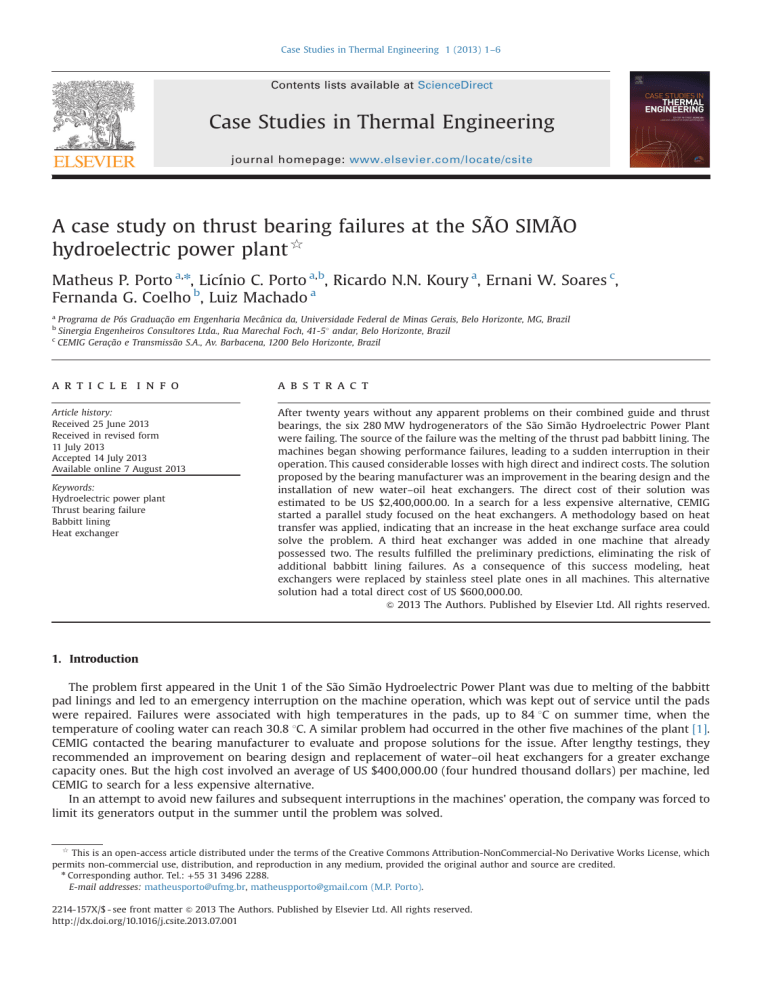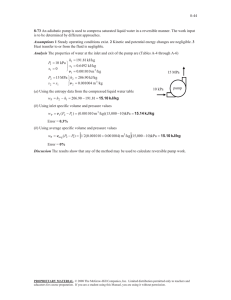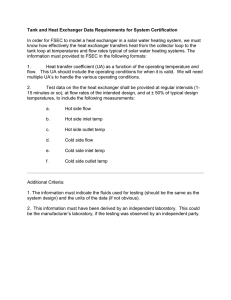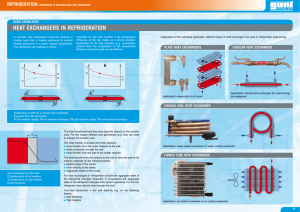
Case Studies in Thermal Engineering 1 (2013) 1–6
Contents lists available at ScienceDirect
Case Studies in Thermal Engineering
journal homepage: www.elsevier.com/locate/csite
A case study on thrust bearing failures at the SÃO SIMÃO
hydroelectric power plant$
Matheus P. Porto a,n, Licínio C. Porto a,b, Ricardo N.N. Koury a, Ernani W. Soares c,
Fernanda G. Coelho b, Luiz Machado a
a
b
c
Programa de Pós Graduação em Engenharia Mecânica da, Universidade Federal de Minas Gerais, Belo Horizonte, MG, Brazil
Sinergia Engenheiros Consultores Ltda., Rua Marechal Foch, 41-51 andar, Belo Horizonte, Brazil
CEMIG Geração e Transmissão S.A., Av. Barbacena, 1200 Belo Horizonte, Brazil
a r t i c l e i n f o
abstract
Article history:
Received 25 June 2013
Received in revised form
11 July 2013
Accepted 14 July 2013
Available online 7 August 2013
After twenty years without any apparent problems on their combined guide and thrust
bearings, the six 280 MW hydrogenerators of the São Simão Hydroelectric Power Plant
were failing. The source of the failure was the melting of the thrust pad babbitt lining. The
machines began showing performance failures, leading to a sudden interruption in their
operation. This caused considerable losses with high direct and indirect costs. The solution
proposed by the bearing manufacturer was an improvement in the bearing design and the
installation of new water–oil heat exchangers. The direct cost of their solution was
estimated to be US $2,400,000.00. In a search for a less expensive alternative, CEMIG
started a parallel study focused on the heat exchangers. A methodology based on heat
transfer was applied, indicating that an increase in the heat exchange surface area could
solve the problem. A third heat exchanger was added in one machine that already
possessed two. The results fulfilled the preliminary predictions, eliminating the risk of
additional babbitt lining failures. As a consequence of this success modeling, heat
exchangers were replaced by stainless steel plate ones in all machines. This alternative
solution had a total direct cost of US $600,000.00.
& 2013 The Authors. Published by Elsevier Ltd. All rights reserved.
Keywords:
Hydroelectric power plant
Thrust bearing failure
Babbitt lining
Heat exchanger
1. Introduction
The problem first appeared in the Unit 1 of the São Simão Hydroelectric Power Plant was due to melting of the babbitt
pad linings and led to an emergency interruption on the machine operation, which was kept out of service until the pads
were repaired. Failures were associated with high temperatures in the pads, up to 84 1C on summer time, when the
temperature of cooling water can reach 30.8 1C. A similar problem had occurred in the other five machines of the plant [1].
CEMIG contacted the bearing manufacturer to evaluate and propose solutions for the issue. After lengthy testings, they
recommended an improvement on bearing design and replacement of water–oil heat exchangers for a greater exchange
capacity ones. But the high cost involved an average of US $400,000.00 (four hundred thousand dollars) per machine, led
CEMIG to search for a less expensive alternative.
In an attempt to avoid new failures and subsequent interruptions in the machines' operation, the company was forced to
limit its generators output in the summer until the problem was solved.
$
This is an open-access article distributed under the terms of the Creative Commons Attribution-NonCommercial-No Derivative Works License, which
permits non-commercial use, distribution, and reproduction in any medium, provided the original author and source are credited.
n
Corresponding author. Tel.: +55 31 3496 2288.
E-mail addresses: matheusporto@ufmg.br, matheuspporto@gmail.com (M.P. Porto).
2214-157X/$ - see front matter & 2013 The Authors. Published by Elsevier Ltd. All rights reserved.
http://dx.doi.org/10.1016/j.csite.2013.07.001
2
M.P. Porto et al. / Case Studies in Thermal Engineering 1 (2013) 1–6
Nomenclature
A
c
LMTD
p
Q_
ρ
T
T
U
Un
surface area, m2
specific heat capacity, kJ 1C 1 kg 1
log mean temperature difference, 1C
pressure, kPa
heat transfer, kW
density, kg m 3
average temperature, 1C
temperature, 1C
overall coefficient of heat transfer,
kW 1C 1 m 2
Modified overall coefficient of heat transfer
(UA), kW 1C 1
V_
v
_
W
flux, m3 s 1
viscosity, m2 s 1
power, kW
Subscripts
1,2,3,4 and 5 see Figs. 2 and 3
b
bearing
e
heat exchanger
o
oil
p
pump
s
thrust pads
w
water
1.1. A new point of view
While searching for a simpler and cheaper alternative for the problem at hand and one that could be implemented in the
shortest amount of time, the research targeted the water–oil heat exchangers as the best solution. An increase in the
exchange surface area would decrease the temperature of the oil flowing out of the heat exchangers, providing the
necessary decrease in the thrust pad temperature. Making use of an existent spare heat exchanger, it was considered adding
it to Unit 1, with the oil circuit in series and water in parallel. Fig. 1 shows the original configuration of the oil cooling system,
in which a third heat exchanger was placed.
1.2. Model
To determine the consequences of installing a third heat exchanger, a semi-empirical model was developed, based on
values measured in Unit no. 1 with the original configuration set (two heat exchangers), as can be seen in Table 1. Pipes,
pumps and heat exchangers external surfaces were considered adiabatic.
Due to the low temperature of water during testing the thrust pad average temperature reached only 77.3 1C, with a
highest value of 78.5 1C in pad no. 10.
Fig. 1. Combined bearing oil refrigeration system.
M.P. Porto et al. / Case Studies in Thermal Engineering 1 (2013) 1–6
3
Table 1
Main operational systems present in the experiment.
Parameter
Value
Generator output
Thrust bearing pads average temperature
285 MW
Oil temperature at bearing inlet
Oil temperature at bearing outlet
Water temperature at heat exchangers inlet
Cooling water flux per heat exchanger
Pump differential pressure
T s ¼ 77:3 1C
T o5 ¼ 37:0 1C
T o1 ¼ 45:0 1C
T wl ¼ 23:4 1C
V_ w ¼ 0:0426 m3 s1
Δp ¼ 192:6 kPa
The relations to calculate the required power and the volumetric flow rate by the oil pump for a third heat exchanger
were obtained from the data included in the product description published by the pump manufacturer (IMO) and properties
of the Mobil DTE Heavy lubricant provided by Mobil Oil.
(a) Oil volumetric flow rate versus pump differential pressure:
V_ o ¼ 1:707 1012 Δp3 þ 4417 109 Δp2 4586 106 Δp þ 0:03473;
ð1Þ
where V_ o ðm3 s1 Þ is the oil volumetric flow rate and Δp (kPa) is the pump differential pressure. This equation is valid only if
the oil temperature at the pump inlet lies between 40 1C and 48 1C and leads to a maximum error of 0.7% at a differential
pressure of 1200 kPa, being smaller at lower differential pressures.
(b) Oil Mobil DTE Heavy properties:
ρo ¼ 0:600T o þ 888:5;
ð2Þ
vo ¼ 8:8 108 T 2o 1:124 105 T o þ 3:937 104 ;
ð3Þ
co ¼ 0:00347T o þ 1:801;
ð4Þ
1
1
1
where ρo ðkg m3 Þ is the density, vo (m s ) is the kinematic viscosity, co (kJ 1C kg ) is the specific heat capacity and
To (1C) is the oil temperature. These equations are valid for 40–55 1C oil temperature range.
(c) Power required to drive the oil pump:
2
_ ¼ 0:03475Δp3:377 108 v2 þ 9:572 104 vo þ 1:921;
W
o
ð5Þ
_ (kW) is the power required to drive the oil pump. This equation is valid only if the oil temperature at the pump
where W
inlet lies between 40 1C and 48 1C and leads to a maximum error of 1.0%.
Fig. 2 shows the oil cooling system of São Simão Unit no. 1 in its original configuration with two heat exchangers in series
in oil and parallel in water, and the presented values to Unit 1 in operation at nominal output (see Table 1). In that
configuration the oil volumetric flow rate can be calculated by Eq. (1) with Δp ¼ 192:6 kPa, V o ¼ 0:0340 m3 s1 .
The heat transferred in the combined guide and thrust bearing can be calculated by Eq. (6) where the oil properties are
determined for the average temperature of 41 1C:
Q_ b ¼ ρo V_ o co ΔT o
¼ 863:9 0:034 1:942 ð45:037:0Þ
¼ 456:3 kW:
ð6Þ
_ ¼ 13:47 kW.
With the oil inlet at 45 1C at the pump, the required power can be calculated using Eq. (5), leading to W
In the pumping process, heat transferred to the oil can be calculated by applying the first law of thermodynamics to the
pump's control volume
_ V_ o Δp ¼ 13:470:0340 192:6 ¼ 6:92 kW;
Q_ p ¼ W
ð7Þ
_ (kW) is calculated by Eq. (5) and Vo (m3 s 1) by Eq. (1), with Δp in (kPa).
where W
The oil temperature at the inlet of the first heat exchanger may be derived by applying
T o2 ¼ T o1 þ
Q_ p
ρo V_ o co
¼ 45:0 þ
6:92
¼ 45:1 1C:
861:5 0:034 1:956
With the oil properties calculated by Eqs. (2)–(4).
ð8Þ
4
M.P. Porto et al. / Case Studies in Thermal Engineering 1 (2013) 1–6
Fig. 2. Oil cooling system in its original configuration.
Fig. 3. New configuration for the oil cooling system.
In the heat exchangers the oil transfers a heat flow Q_ o to the water, which is calculated as follows:
Q_ o ¼ Q_ b þ Q_ p ¼ 463:2 kW:
ð9Þ
Based on classical heat exchangers theory [2,3], and using the above data, the following results are presented:
T o3 ¼ 40:6 1C, oil temperature at the second heat exchanger inlet.
LMTD1 ¼ 18:7 1C, logarithmic mean temperature difference in the 1st heat exchanger.
LMTD2 ¼ 14:8 1C, logarithmic mean temperature difference in the 2nd heat exchanger.
Q_ e1 ¼ 258:8 kW, heat flow in the 1st heat exchanger.
Q_ e2 ¼ 204:8 kW, heat flow in the 2nd heat exchanger.
U ne ¼ UA ¼ 13:85 kW 1C1 , modified overall coefficient of heat transfer for each heat exchanger.
The insertion of the 3rd heat exchanger was evaluated through the same methodology mentioned above, under the
following premises:
The additional loss in the oil derived from the 3rd heat exchanger insertion is 47.3 kPa, as measured in a specific test [4],
so the differential pressure in the pump is Δp ¼ 192:6 þ 47:3 ¼ 239:9 kPa.
The heat flow transferred to the oil in the pump will be computed from the new values of the inlet pump oil temperature
(To1) and differential pressure (ΔpÞ.
The water volume flow in each heat exchanger will be reduced to 0:0313 m3 s1 (CEMIG's request), leading to
0:0939 m3 s1 for the three heat exchangers.
The modified overall coefficient of heat transfer will be computed for the new water volume flow.
M.P. Porto et al. / Case Studies in Thermal Engineering 1 (2013) 1–6
5
The heat exchangers inlet water temperature will remain the same, i.e., 23.4 1C.
The difference between the average thrust pad temperature and the oil temperature in the bearing inlet will remain the
same, i.e., ΔT so ¼ T s T o4 ¼ 77:337:0 ¼ 40:3 1C.
The expected thrust pads average temperature is
T s ¼ T o5 þ ΔT so :
ð10Þ
The heat flow dissipated in combined thrust bearing will vary with the square root of the oil coefficient of viscosity in the
oil-film [5].
2. Results
Fig. 3 shows the proposed configuration for the oil cooling system with the insertion of the 3rd heat exchanger, in series
with the two existents.
Table 2 compares the predicted values with experimental ones obtained by CEMIG for Unit no. 1 in steady-state
operation at nominal output.
A new computation, which is done for the real water temperature at the heat exchangers inlet, 23.8 1C, and pressure
difference, 224.0 kPa, gives the values presented in Table 3.
The small difference between the predicted and measured temperature values of both the oil and the pads demonstrates
the model reliability.
Another computation was done to consider the highest inlet water temperature ever registered at the São Simão Power
Plant, the results of which are shown in Table 4.
Table 2
Predicted and measured values comparison.
Parameter
Tw1: Water temperature at heat exchangers inlet, 1C
V_ w : Water volume flow in each heat exchanger, m3 s 1
Δp: Pressure difference in the pump, kPa
To5: Oil temperature at combined bearing inlet, 1C
To2: Oil temperature at pump outlet, 1C
T s : Average temperature of thrust pads, 1C
Values
Predicted
Measured
23.4
0.0313
23.8
0.0313
239.9
32.5
41.1
72.8
224.0
33.5
42.0
74.8
Table 3
Calculated and measured values—a new computation for the same input, T w1 ¼ 23:8 1C and Δpo ¼ 2:240 bar.
Parameter
Tw1: Water temperature at heat exchangers inlet, 1C
V_ w : Water volume flow in each heat exchanger, m3 s 1
Δp: Pressure difference in the pump, kPa
To5: Oil temperature at combined bearing inlet, 1C
To2: Oil temperature at pump outlet, 1C
T s : Average temperature of thrust pads, 1C
Values
Predicted
Measured
23.8
0.0313
23.8
0.0313
224.0
32.9
41.5
73.2
224.0
33.5
42.0
74.8
Table 4
Predicted values with T w1 ¼ 30:8 1C.
Parameter
Tw1: Water temperature at heat exchangers inlet, 1C
V_ w : Water volume flow in each heat exchanger, m3 s 1
Δp: Pressure difference in the pump, kPa
To5: Oil temperature at combined bearing inlet, 1C
To2: Oil temperature at pump outlet, 1C
T s : Average temperature of thrust pads, 1C
Predicted
30.8
0.0313
224.0
39.3
47.3
79.6
6
M.P. Porto et al. / Case Studies in Thermal Engineering 1 (2013) 1–6
The average pad temperature predicted was 79.6 1C, which is sufficiently lower than 84 1C, the temperature at which the
failures occurred. In all the cases, the simulated pressure difference and the power required for the oil pump lie within the
technical limits recommended by the manufacturer for the pump and driving motor.
3. Conclusions
The insertion of an on hand heat exchanger in a new configuration was an excellent solution because it generated a good
performance in a short amount of time with very low cost. The test performed using three heat exchangers rather than two
confirmed the models predicted values for the oil and thrust pad temperatures with a satisfactory precision and allowed the
Unit no. 1 to operate at nominal output with no restrictions in a timely manner.
CEMIG extended the alternative solution to the other machines, where the original shell-and-tubes heat exchangers were
changed to stainless steel plate ones. In spite of changes performed in the oil cooling system, the oil pump and its driving
motor lied inside the limit values prescribed by its manufacturer. The total direct cost was US $600,000.00 (six hundred
thousand dollars) for the six machines, with a significant savings of US $1,800,000.00 (one million and eight hundred
thousand dollars) when compared with the solution proposed by the bearing manufacturer.
Furthermore, the estimated time for the bearing manufacturer's proposal implementation was a minimum of
approximately forty-five days while CEMIG's alternative was implemented in fifteen days, thus reducing indirect costs
considerably in applying the alternative solution.
References
[1] Porto LC. Avaliação dos Problemas de Superaquecimento dos Mancais de Escora das Unidades Geradoras da UHE São Simão. CEMIG. Technical Report.
Belo Horizonte; 1997.
[2] Incropera FP, DeWitt DP, Bergman TL, Lavine AS. Fundamentals of heat and transfer. Danvers: John Wiley & Sons; 2002.
[3] Kern DQ. Process heat transfer. Tokio: McGraw-Hill Kogakusha; 1950.
[4] Porto LC. Estudo e Proposição de Melhorias no Sistema de Troca de Calor do Mancal Combinado das Unidades Geradoras da UHE São Simão. CEMIG.
Technical Report. Belo Horizonte; 1999.
[5] Wiedemann E, Kellenberger W. Konstruktion Elektrischer Maschinen. Wien: Springer-Verlag; 1967.





